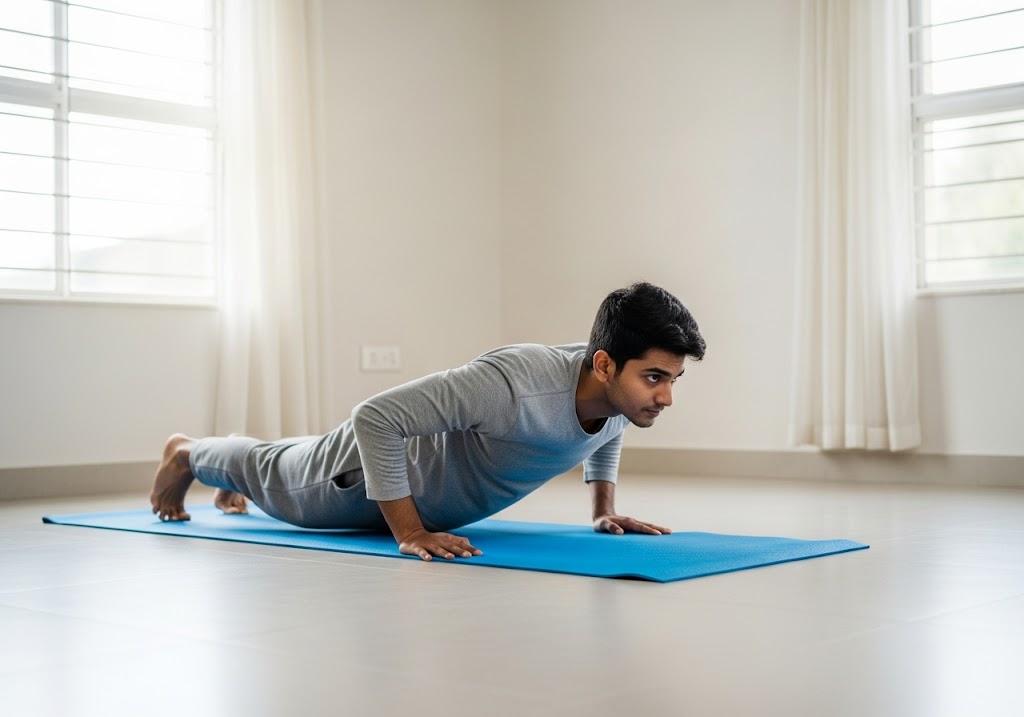20 best resistance band bicep workout exercises are: Standing Bicep Curls for strength, Hammer Curls for arm thickness, Concentration Curls for peak, 21s Curls for activation, Reverse Curls for forearms, Single-Arm Curls for balance, Wide-Grip Curls for inner biceps, Drag Curls for outer biceps, Preacher Curls for contraction, Isometric Holds for endurance, Crossbody Hammer Curls for cross strength, High Cable Curls for long head, Overhead Cable Curls for mass, Band Pull-Apart Curls for functional strength, Spider Curls for strict form, Zottman Curls for full arm, Band Assisted Curls for beginners, Alternating Curls for stability, Band Bicep Burnouts for stress, Cheat Curls for progression.
Want to build impressive biceps without expensive gym equipment? A resistance band bicep workout provides constant tension throughout the entire range of motion, making it perfect for building lean muscle mass and achieving that coveted arm pump. These versatile training tools offer unique advantages for bicep development through variable resistance patterns that traditional weights cannot replicate.
20 Best Resistance Band Bicep Workout Exercises
These ten proven exercises represent the most effective resistance band bicep workout movements for building size, strength, and definition. Each exercise targets the biceps from different angles while providing unique resistance challenges for complete arm development.
| Exercise | Primary Target | Difficulty | Equipment | Benefits |
| Standing Bicep Curls | Biceps Brachii | Beginner | Tube band | Basic strength |
| Hammer Curls | Brachialis, Biceps | Beginner | Tube band | Arm thickness |
| Concentration Curls | Biceps Peak | Intermediate | Tube band | Peak development |
| 21s Curls | Full Biceps | Advanced | Tube band | Complete activation |
| Reverse Curls | Brachioradialis | Intermediate | Tube band | Forearm strength |
| Single-Arm Curls | Biceps Unilateral | Intermediate | Tube band | Balance correction |
| Wide-Grip Curls | Biceps Short Head | Intermediate | Tube band | Inner biceps |
| Drag Curls | Biceps Long Head | Advanced | Tube band | Outer biceps |
| Preacher Curls | Biceps Isolation | Intermediate | Tube band | Peak contraction |
| Isometric Holds | Full Biceps | Advanced | Tube band | Strength endurance |
1. Standing Bicep Curls
Standing bicep curls form the foundation of any effective resistance band bicep workout routine. Stand on the band with feet shoulder-width apart and curl handles toward your shoulders with palms facing up. This exercise builds basic bicep strength while teaching proper form and movement patterns essential for arm development.
How to do it?
- Stand on the resistance band with feet shoulder-width apart
- Grip handles with palms facing up
- Keep elbows close to your sides throughout the movement
- Curl handles toward your shoulders in a controlled motion
- Squeeze biceps at the top of the movement
- Slowly lower back to starting position
2. Hammer Curls
Hammer curls target the brachialis muscle underneath the biceps, creating arm thickness and overall mass. Perform curls with palms facing each other throughout the movement to emphasize different muscle fibers. This variation is crucial for complete arm development in your resistance band bicep workout program.
How to do it?
- Stand on the band with feet shoulder-width apart
- Hold handles with palms facing each other (neutral grip)
- Keep elbows stationary at your sides
- Curl handles up toward shoulders maintaining neutral grip
- Focus on squeezing the brachialis muscle
- Lower with control to starting position
3. Concentration Curls
Concentration curls provide intense bicep isolation by eliminating momentum and focusing on pure muscle contraction. Sit with elbow braced against your inner thigh and curl with maximum focus on the peak contraction. This exercise builds the bicep peak that creates impressive arm definition and shape.
How to do it?
- Sit on a bench or chair with legs spread
- Step on one end of the band with your foot
- Brace your working elbow against your inner thigh
- Hold the handle with palm facing up
- Curl with maximum focus on peak contraction
- Eliminate all momentum and body swing
4. 21s Curls
The 21s method involves performing 7 partial reps from bottom to middle, 7 from middle to top, then 7 full range reps. This advanced technique provides complete muscle fiber recruitment and intense metabolic stress for maximum bicep growth in your resistance band bicep workout routine.
How to do it?
- Stand on the band with feet shoulder-width apart
- Perform 7 partial reps from bottom position to halfway up
- Immediately perform 7 partial reps from halfway to full contraction
- Finish with 7 full range of motion reps
- Maintain constant tension throughout all 21 repetitions
- Rest only after completing the full sequence
5. Reverse Curls
Reverse curls target the brachioradialis and help balance your arm development while building impressive forearm strength. Perform curls with palms facing down to emphasize these often-neglected muscles. This exercise prevents imbalances and improves grip strength for better performance in all pulling exercises.
How to do it?
- Stand on the band with feet shoulder-width apart
- Grip handles with palms facing down (overhand grip)
- Keep elbows close to your sides
- Curl handles upward focusing on forearm muscles
- Squeeze at the top position
- Lower slowly emphasizing the negative portion
6. Single-Arm Curls
Single-arm curls address strength imbalances between arms while providing unilateral training benefits. Focus on working each arm independently to ensure balanced development. This exercise reveals and corrects strength differences that bilateral training often masks in resistance band bicep workout sessions.
How to do it?
- Stand on the band with one foot
- Hold one handle with the corresponding arm
- Keep your non-working arm relaxed at your side
- Curl with focus on the working arm only
- Complete all reps on one arm before switching
- Compare strength and adjust training accordingly
7. Wide-Grip Curls
Wide-grip curls emphasize the short head of the biceps, building width and creating impressive arm circumference. Use a wider grip position to target the inner portion of the biceps more effectively. This variation adds variety to your resistance band bicep workout while targeting specific muscle areas.
How to do it?
- Stand on the band with feet wider than shoulder-width
- Hold handles with a wider grip than normal
- Keep elbows slightly away from your sides
- Curl focusing on the inner portion of biceps
- Emphasize the squeeze at peak contraction
- Control the negative portion of the movement
8. Drag Curls
Drag curls involve pulling the band straight up along your torso rather than curling forward, targeting the long head of the biceps. This exercise builds the outer portion of the biceps that creates arm width when viewed from the front. Focus on keeping elbows back throughout the movement.
How to do it?
- Stand on the band with feet shoulder-width apart
- Start with handles at your sides
- Pull the band straight up along your torso
- Keep elbows pulled back behind your body
- Drag handles up to chest level
- Focus on the long head of the biceps
9. Preacher Curls
Preacher curls eliminate momentum and provide strict bicep isolation through supported arm positioning. Use a bench or stable surface to support your arms while curling. This exercise maximizes peak contraction and builds the bicep development visible in flexed poses.
How to do it?
- Sit at a bench or use a stable surface for arm support
- Step on the band and hold handle with one hand
- Support your working arm against the bench surface
- Curl with strict form eliminating momentum
- Focus on maximum peak contraction
- Lower slowly to maintain tension
10. Isometric Holds
Isometric holds involve maintaining peak contraction for extended periods, building strength endurance and muscle definition. Hold the top position of any curl variation for 10-30 seconds to increase time under tension. This technique intensifies any resistance band bicep workout exercise.
How to do it?
- Perform any curl variation to the peak contracted position
- Hold the top position for 10-30 seconds
- Maintain maximum muscle tension throughout the hold
- Focus on breathing steadily during the hold
- Lower slowly after completing the hold time
- Increase hold time progressively as strength improves
For comprehensive arm development that complements bicep training, exploring resistance band workouts for men provides additional upper body exercises for complete development.
11. Crossbody Hammer Curls
Crossbody hammer curls involve curling the band across your body rather than straight up, targeting the brachialis from a different angle while engaging core stabilization muscles. This movement pattern improves functional strength and creates unique muscle activation patterns not achieved with traditional curls.
How to do it?
- Stand on the band with feet shoulder-width apart
- Hold handles with neutral grip (palms facing each other)
- Curl one handle diagonally across your body toward opposite shoulder
- Keep elbow close to your side throughout the movement
- Focus on the brachialis muscle contraction
- Return to starting position and repeat on other side
12. High Cable Curls
High cable curls simulate the classic high pulley cable curl using a door anchor positioned high. This exercise targets the long head of the biceps while creating an impressive peak contraction. The high angle provides unique resistance that builds both mass and definition in the upper biceps.
How to do it?
- Anchor the band high on a door or pull-up bar
- Face the anchor point and grab both handles
- Start with arms extended forward parallel to the floor
- Curl handles toward your face keeping elbows high
- Squeeze biceps at peak contraction
- Control the eccentric portion slowly
13. Overhead Cable Curls
Overhead cable curls target the short head of the biceps by positioning your arms overhead throughout the movement. This exercise builds impressive bicep width and creates the dramatic arm sweep visible from the front. The overhead position provides constant tension throughout the entire range of motion.
How to do it?
- Anchor the band high and face away from the anchor
- Start with arms extended overhead holding handles
- Keep elbows high and stationary throughout the movement
- Curl handles down behind your head
- Focus on the short head of the biceps
- Extend arms back to starting position with control
14. Band Pull-Apart Curls
Band pull-apart curls combine horizontal pulling with bicep curling, targeting both the biceps and rear deltoids simultaneously. This compound movement improves posture while building functional arm strength. The exercise creates unique tension patterns that challenge stabilization muscles.
How to do it?
- Hold a loop band with arms extended in front of you
- Pull the band apart horizontally to stretch it across your chest
- While maintaining the stretch, curl your fists toward your shoulders
- Focus on squeezing both biceps and rear deltoids
- Lower arms back to extended position maintaining band tension
- Repeat the pull-apart and curl sequence
15. Spider Curls
Spider curls require an incline position that completely eliminates momentum and body swing, providing pure bicep isolation. Lean forward against a bench or stable surface and curl with strict form. This exercise builds incredible bicep peak development and muscle control.
How to do it?
- Lean forward against an incline bench or stable surface
- Step on the band and hold handles with arms hanging straight down
- Keep chest pressed against the support throughout
- Curl handles toward your shoulders with strict form
- Eliminate all momentum and body movement
- Focus on pure bicep contraction and control
16. Zottman Curls
Zottman curls combine concentric bicep curls with eccentric reverse curls, providing complete forearm and bicep development in one movement. Curl up with palms up, then rotate to palms down for the lowering phase. This advanced technique targets all arm muscles while building grip strength.
How to do it?
- Stand on the band with feet shoulder-width apart
- Curl handles up with palms facing up (supinated grip)
- At the top, rotate wrists so palms face down
- Lower slowly with palms facing down (pronated grip)
- Rotate back to palms up at the bottom
- Repeat the curl-rotate-lower sequence
17. Band Assisted Curls
Band assisted curls use lighter resistance to perfect form and increase training volume without overloading the joints. This exercise is ideal for beginners learning proper movement patterns or for advanced trainees performing high-volume sessions for muscle endurance and pump.
How to do it?
- Use a lighter resistance band than normal
- Focus on perfect form rather than heavy resistance
- Perform slow, controlled repetitions with emphasis on technique
- Feel every portion of the movement pattern
- Use this exercise for warm-ups or high-volume training
- Progress to heavier resistance as form improves
18. Alternating Curls
Alternating curls involve curling one arm while the other remains extended, creating core stability challenges while building unilateral strength. This exercise improves coordination and reveals strength imbalances between arms. The alternating pattern increases time under tension for enhanced muscle development.
How to do it?
- Stand on the band with feet shoulder-width apart
- Hold both handles with palms facing up
- Curl one handle while keeping the other arm extended
- Focus on maintaining balance and core stability
- Lower the working arm while curling the opposite arm
- Continue alternating arms throughout the set
19. Band Bicep Burnouts
Band bicep burnouts involve performing high repetitions with lighter resistance to create intense metabolic stress and muscle pump. This advanced technique increases blood flow, nutrient delivery, and growth hormone release for enhanced muscle development and definition.
How to do it?
- Use moderate to light resistance band
- Perform 20-50 repetitions with minimal rest
- Focus on maintaining constant tension throughout
- Push through the burn when muscles begin to fatigue
- Maintain strict form despite high repetition count
- Use as a finisher at the end of bicep workouts
20. Cheat Curls
Cheat curls involve using slight momentum to handle heavier resistance than strict curls allow, enabling progressive overload for strength development. Use controlled momentum to start the movement, then focus on the eccentric portion. This advanced technique builds strength and size when used properly.
How to do it?
- Use heavier resistance than normal strict curls
- Generate slight momentum from your legs and hips to start the curl
- Focus on controlling the eccentric (lowering) portion slowly
- Don’t let momentum completely take over the movement
- Use sparingly as an advanced overload technique
- Always prioritize form over excessive momentum
Find out how many calories burned jumping jacks and the exact numbers for how many calories burn in skipping, including how many calories burn in 1000 skipping.

Anatomy of the Bicep Muscles
Understanding bicep anatomy helps create more effective resistance band bicep workout programs that target all muscle fibers for complete development. The biceps brachii consists of two heads that work together but can be emphasized differently through exercise selection and grip variations in your resistance band bicep workout routine.
The long head originates from the shoulder blade and creates the outer portion of the biceps that’s visible from the front. This head responds well to exercises with arms behind the body, such as drag curls and incline curls in your resistance band bicep workout. The short head originates from the shoulder blade’s front portion and creates bicep width and thickness.
Build lean muscle naturally with bodyweight exercises.
| Muscle | Location | Primary Function | Best Exercises | Training Focus |
| Biceps Long Head | Outer arm | Arm flexion, supination | Drag curls, hammer curls | Arm width |
| Biceps Short Head | Inner arm | Arm flexion, supination | Wide-grip curls | Arm thickness |
| Brachialis | Under biceps | Arm flexion | Hammer curls, reverse curls | Arm mass |
| Brachioradialis | Forearm | Arm flexion | Reverse curls | Forearm strength |
The brachialis lies underneath the biceps and contributes significantly to arm thickness when developed properly. This muscle responds well to hammer curls and reverse curls in your resistance band bicep workout routine. The brachioradialis assists in arm flexion while building impressive forearm strength and size.
For comprehensive back development that supports pulling strength, calisthenics back exercises provides essential exercises that complement bicep training for balanced upper body development.
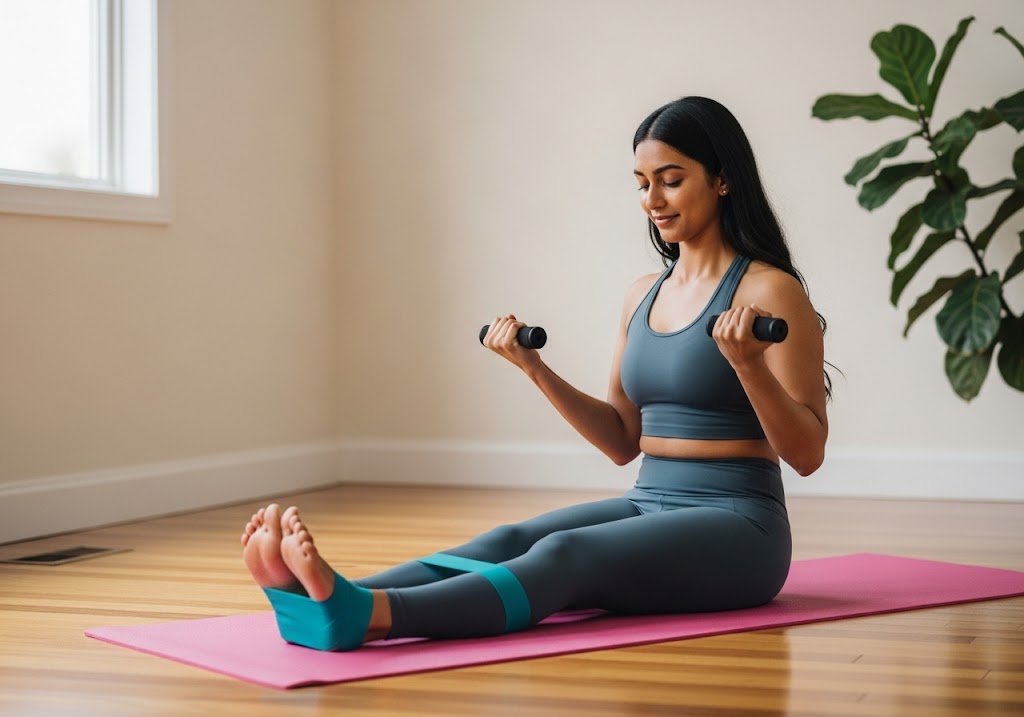
Benefits of Training the Biceps With Bands
Training biceps with resistance bands offers unique advantages that traditional weights cannot replicate for optimal muscle development. The variable resistance pattern provides increasing tension as the band stretches, matching the natural strength curve of the biceps for maximum muscle activation throughout the entire range of motion.
- Constant Tension: Bands maintain tension throughout the full range of motion, eliminating dead spots common with free weights
- Accommodating Resistance: Resistance increases as muscles reach their strongest position, maximizing muscle fiber recruitment
- Joint-Friendly Training: Smooth resistance curves reduce joint stress while maintaining muscle-building stimulus
- Portability: Complete bicep workouts anywhere without bulky equipment or gym memberships
- Variable Angles: Easy adjustment of resistance angles targets biceps from multiple positions
- Peak Contraction: Enhanced muscle squeeze at the top of each repetition for maximum growth stimulus
- Injury Prevention: Lower impact forces reduce injury risk while maintaining training intensity
- Cost Effectiveness: Single band set provides lifetime of bicep training at fraction of gym costs
Know the difference: Push-ups vs Bench Press-which one wins for strength?
The elastic properties of bands create unique muscle activation patterns that complement traditional weight training. Peak muscle tension occurs when biceps are in their strongest position, maximizing the growth stimulus throughout each repetition of your resistance band bicep workout.
For complete bodyweight training that supports overall upper body development, calisthenics exercises provides foundational movements that enhance functional strength alongside your resistance band bicep workout routine.
For women seeking specialized bicep training, resistance band workouts for women provides gender-specific programming and exercise modifications.
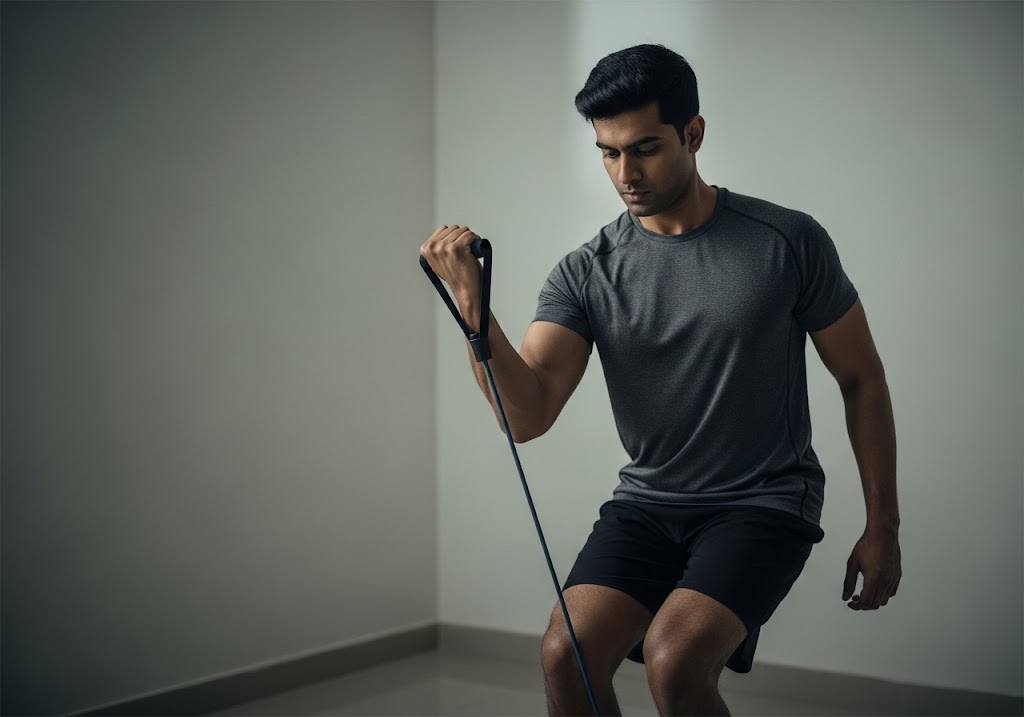
Best Resistance Band Bicep Exercises (+ Sample Workout)
These exercises represent the most effective movements for building impressive biceps using resistance band bicep workout methods. Each exercise targets different aspects of bicep development while providing unique training stimulus for complete muscle growth.
The key to effective bicep training lies in exercise variety and progressive overload through increased resistance, repetitions, or training frequency. Focus on perfect form and controlled movements rather than rushing through repetitions for maximum muscle activation and growth.
| Exercise | Sets | Reps | Rest | Focus |
| Standing Bicep Curls | 3 | 12-15 | 60s | Basic strength |
| Hammer Curls | 3 | 10-12 | 60s | Arm thickness |
| Concentration Curls | 2 | 8-10 each | 45s | Peak development |
| 21s Curls | 2 | 21 total | 90s | Complete activation |
| Reverse Curls | 2 | 12-15 | 45s | Forearm balance |
This sample workout provides comprehensive bicep development through varied exercises and rep ranges. Perform this routine 2-3 times per week with at least 48 hours recovery between sessions for optimal muscle growth and strength development.
Progressive overload remains crucial for continued muscle growth in resistance band bicep workout programs. Increase resistance by using heavier bands, adding repetitions, or performing additional sets as strength improves over time with your resistance band bicep workout consistency.
For developing a wider back that complements impressive biceps, how to get a wider back provides essential exercises for creating the V-taper physique that enhances overall arm appearance.
Sample Bicep Workout Routine With Bands
This comprehensive resistance band bicep workout routine targets all aspects of bicep development through strategic exercise selection and programming. The workout combines different grip positions, angles, and intensities for complete muscle stimulation and growth.
Beginner Routine (Weeks 1-4)
- Standing Bicep Curls: 2 sets x 15 reps
- Hammer Curls: 2 sets x 12 reps
- Reverse Curls: 2 sets x 12 reps
- Rest: 60 seconds between sets
- Frequency: 2x per week
Learn how to do dumbbell bench press with proper form for chest gains.
Intermediate Routine (Weeks 5-8)
- Standing Bicep Curls: 3 sets x 12-15 reps
- Hammer Curls: 3 sets x 10-12 reps
- Concentration Curls: 2 sets x 8-10 each arm
- Reverse Curls: 2 sets x 12-15 reps
- Rest: 45-60 seconds between sets
- Frequency: 3x per week
Advanced Routine (Weeks 9-12)
- Standing Bicep Curls: 3 sets x 10-12 reps
- 21s Curls: 2 sets x 21 total reps
- Hammer Curls: 3 sets x 8-10 reps
- Concentration Curls: 3 sets x 6-8 each arm
- Drag Curls: 2 sets x 8-10 reps
- Isometric Holds: 2 sets x 15-20 seconds
- Rest: 60-90 seconds between sets
- Frequency: 3-4x per week
Progress gradually through each phase, focusing on perfect form before advancing to more challenging routines in your resistance band bicep workout progression. Listen to your body and adjust volume based on recovery capacity and strength improvements from consistent resistance band bicep workout sessions.
For understanding different training approaches that enhance overall strength, how to do a perfect squat provides fundamental movement patterns that support your resistance band bicep workout program.
For balanced training that addresses opposing muscle groups, resistance band workout for triceps provides essential exercises for complete arm development.
Best Bands For Training Your Biceps
Selecting the right resistance bands for your bicep workout with bands ensures optimal training stimulus and exercise variety. Different band types offer unique advantages for specific exercises and training goals in resistance band bicep workout programs.
| Band Type | Best For | Resistance Range | Advantages | Limitations |
| Tube Bands with Handles | General bicep training | Light to Extra Heavy | Comfortable grip, versatile | May snap over time |
| Loop Bands | Preacher curls, assistance | Light to Heavy | Durable, compact | Limited exercises |
| Flat Bands | 21s, high reps | Light to Medium | Gentle on joints | Lower resistance |
| Figure-8 Bands | Hammer curls | Medium to Heavy | Natural grip | Limited range |
| Power Bands | Heavy resistance | Heavy to Extra Heavy | Maximum resistance | Bulky for travel |
Quality indicators include durable materials, comfortable handles, and smooth resistance without binding. Invest in multiple resistance levels to accommodate different exercises and strength progressions in your resistance band bicep workout routine.
Door anchors expand exercise possibilities by allowing various anchor heights and angles. This versatility enables preacher curls, high curls, and other variations that target biceps from different positions for complete muscle development.
trengthen your posterior chain with these essential back calisthenics exercises.

How to Train Biceps Using Resistance Bands?
Learning how to train biceps using resistance bands requires understanding proper setup, form, and progression principles. These fundamentals ensure safe, effective training that maximizes muscle growth while preventing injury and overuse problems.
Setup involves securing the band properly and selecting appropriate resistance for your strength level. Start with lighter resistance to master movement patterns before progressing to heavier bands that challenge your muscles more intensely.
Follow our expert-designed calisthenics workout plan for consistent progress.
Form Fundamentals:
- Maintain neutral spine and engage core throughout exercises
- Keep elbows stationary at your sides during curling movements
- Control both lifting and lowering phases of each repetition
- Focus on squeezing biceps at peak contraction position
- Avoid swinging or using momentum to move the band
- Breathe out during the lifting phase, in during lowering
Progression Principles:
- Start with 2-3 exercises, 2 sets each, 12-15 repetitions
- Add resistance when you can complete all reps with perfect form
- Increase volume gradually through additional sets or exercises
- Include variety through different grip positions and angles
- Allow 48-72 hours recovery between intense bicep sessions
Consistency proves more important than intensity for long-term bicep development. Focus on regular resistance band bicep workout sessions with proper form rather than sporadic high-intensity sessions that may lead to injury or burnout with your resistance band bicep workout routine.
For single-limb training that addresses imbalances and enhances bicep development, unilateral exercises provides excellent techniques for ensuring balanced strength development.
For comprehensive upper body training that supports bicep development, calisthenics back exercises provides complementary pulling exercises for balanced development.
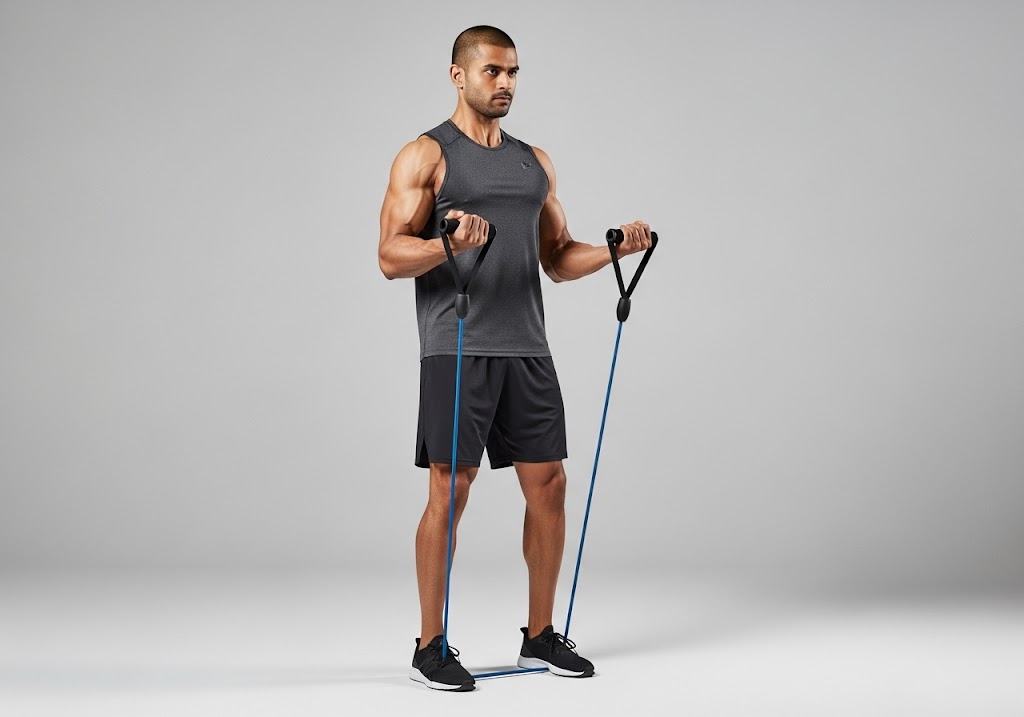
Home Bicep Workout With Resistance Bands
Creating an effective home bicep workout with resistance bands requires minimal space and equipment while delivering professional-level results. This approach eliminates gym membership costs and time constraints while providing flexibility to train whenever convenient.
The beauty of resistance band training lies in its simplicity and effectiveness for building impressive biceps at home. A single set of quality bands provides everything needed for complete bicep development through varied exercises and resistance levels.
Essential Equipment:
- Set of tube bands with handles (light, medium, heavy resistance)
- Door anchor for exercise variety
- Small towel for grip comfort
- Water bottle for hydration
- Timer for rest periods
Space Requirements:
- 6 feet x 6 feet minimum floor space
- Door for anchor attachment
- Stable chair for seated exercises
- Mirror for form checking (optional)
Setup Tips:
- Clear area of obstacles and fragile items
- Check band condition before each workout
- Secure door anchor at appropriate height
- Have multiple resistance levels available
- Keep workout log for progress tracking
The convenience of home training eliminates common excuses while providing consistent training opportunities for your resistance band bicep workout. This consistency proves crucial for bicep development, as muscles respond best to regular, progressive stimulus over time with dedicated resistance band bicep workout sessions.
For understanding different training methodologies that can enhance your results, unilateral vs bilateral training explores various approaches for balanced muscle development.
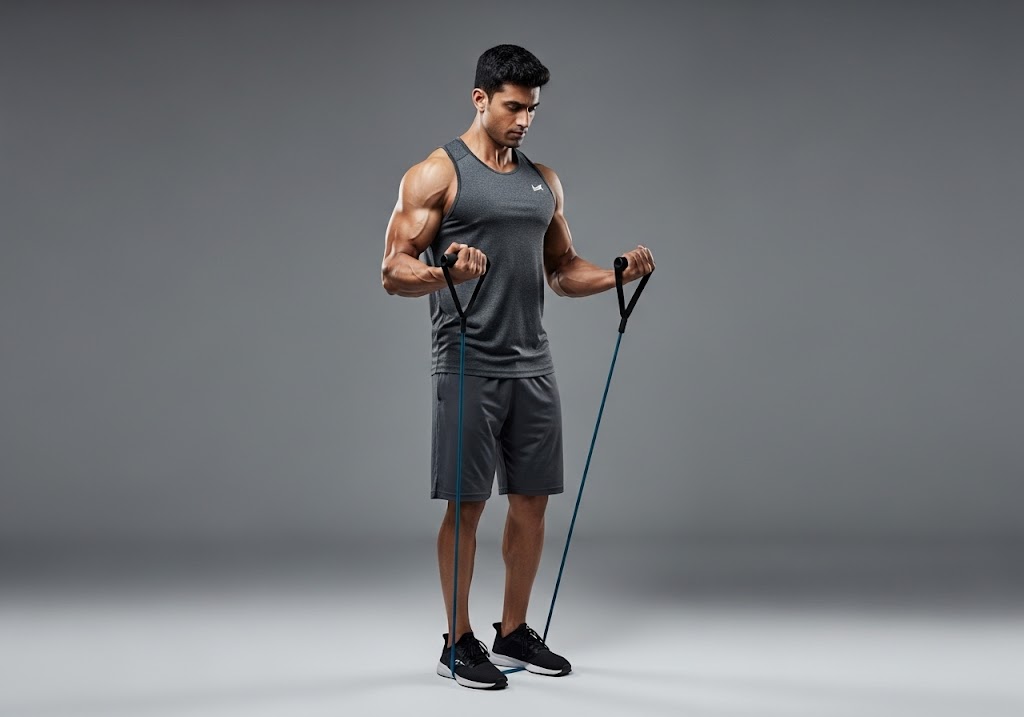
How to Build Biceps With Resistance Bands?
Understanding how to build biceps with resistance bands requires applying muscle-building principles through progressive overload, adequate volume, and proper recovery. These evidence-based strategies ensure optimal muscle growth and strength development over time.
Progressive overload remains the foundation of muscle building, requiring gradual increases in training stress through heavier resistance, more repetitions, or additional training volume. Track your workouts to ensure consistent progression in your resistance band bicep workout program.
Muscle Building Principles:
- Train biceps 2-3 times per week with 48-hour recovery periods
- Perform 10-20 sets per week across all bicep exercises
- Use resistance that causes muscle failure within 6-15 repetitions
- Focus on controlled movements with 2-3 second negatives
- Maintain tension throughout the entire range of motion
- Include variety through different exercises and grip positions
Nutrition Support:
- Consume adequate protein (1.6-2.2g per kg body weight)
- Maintain slight caloric surplus for muscle building
- Stay hydrated for optimal performance and recovery
- Time protein intake around workouts for maximum benefit
Recovery proves equally important as training for muscle growth. Sleep 7-9 hours nightly and manage stress levels to optimize hormonal environment for muscle building and strength development from your resistance band bicep workout program.
For comprehensive training that complements your bicep work, resistance band workouts for women provides complete programming for balanced fitness development.
For understanding different training approaches that can enhance bicep development, unilateral vs bilateral training explores various methods for balanced muscle development.
Resistance Band Bicep Workout for Men
Resistance band bicep workout for men focuses on building impressive size and strength through higher volume and intensity training. Men typically respond well to heavier resistance and more aggressive progression schemes for maximum muscle development.
Male-specific programming emphasizes compound movements that work biceps alongside other muscle groups for maximum training efficiency. This approach builds functional strength while creating the muscular development that enhances overall physique appearance.
| Training Variable | Men’s Program | Rationale | Application |
| Volume | 12-20 sets/week | Higher recovery capacity | More sets per exercise |
| Intensity | 6-12 rep range | Strength and size focus | Heavier resistance |
| Frequency | 3-4x per week | Faster recovery | More training sessions |
| Exercise Selection | Compound emphasis | Time efficiency | Multi-muscle movements |
| Progression | Aggressive loading | Strength adaptation | Frequent resistance increases |
For complete upper body training that enhances your overall program, resistance band workout for triceps provides essential exercises for balanced arm development.

Resistance Band Bicep Workout for Women
Resistance band bicep workout for women emphasizes toning, strength, and functional development while building lean muscle without excessive bulk. Women often prefer higher repetition ranges and moderate resistance for muscle definition and endurance benefits that enhance daily activities.
| Training Variable | Women’s Program | Rationale | Benefits |
| Rep Range | 12-20 reps | Muscle endurance focus | Lean muscle definition |
| Resistance Level | Light to Moderate | Avoid excessive bulk | Feminine aesthetics |
| Training Frequency | 2-3x per week | Hormonal considerations | Sustainable progress |
| Exercise Selection | Circuit emphasis | Metabolic benefits | Fat burning + toning |
| Volume | 8-12 sets/week | Recovery capacity | Balanced development |
| Progression | Gradual increases | Joint safety | Long-term adherence |
| Integration | Full-body focus | Time efficiency | Complete fitness |
Tighten your abs with these resistance band core exercises.
Bicep Band Workout
A focused bicep band workout targets the arms exclusively through specialized exercises and training methods. This concentrated approach allows for maximum bicep stimulation and development in minimal time while providing intense muscle-building stimulus.
Dedicated bicep sessions work best when incorporated into larger training programs that address all muscle groups. This specialization approach can break through plateaus and accelerate bicep development when used strategically.
Specialization Workout Structure:
- Warm-up: Light band movements (5 minutes)
- Main exercises: 4-6 bicep-focused movements
- Intensity techniques: Drop sets, 21s, isometrics
- Cool-down: Stretching and mobility work
- Recovery: 48-72 hours before next bicep session
Exercise Selection Priority:
- Primary: Standing bicep curls, hammer curls
- Secondary: Concentration curls, reverse curls
- Advanced: 21s, drag curls, isometric holds
This focused approach intensifies bicep training while maintaining balance through complementary muscle group training on alternate days. The specialization period should last 4-6 weeks before returning to balanced programming in your resistance band bicep workout schedule.
For comprehensive nutrition strategies that support your training goals, intermittent fasting plan provides structured eating approaches for optimal body composition.
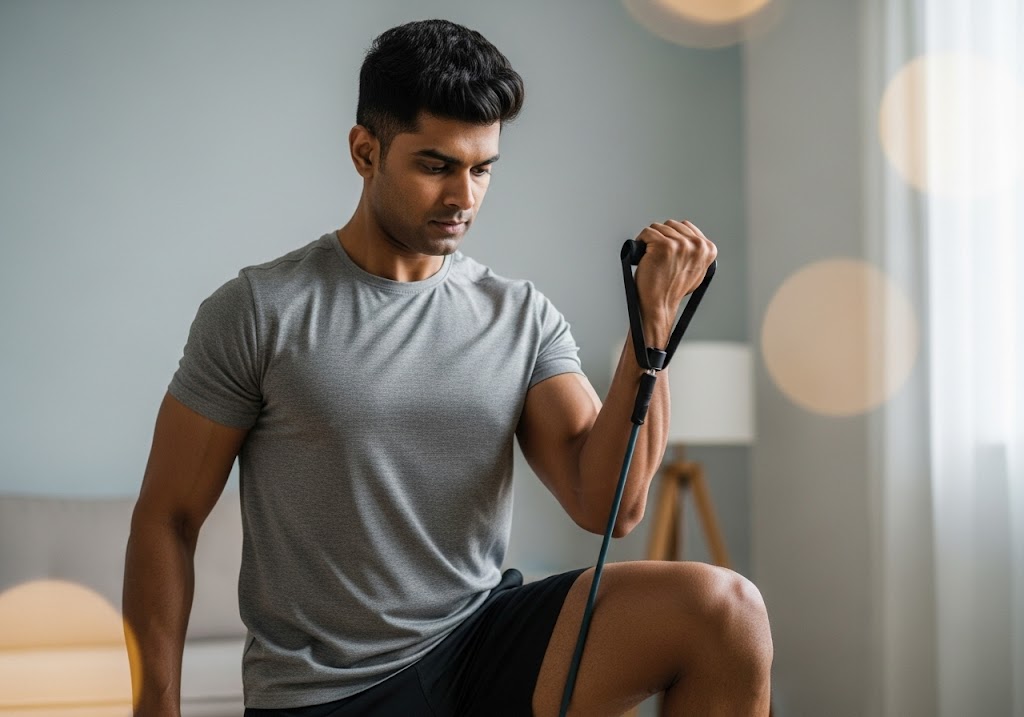
Elastic Band Workout Biceps
Elastic band workout biceps utilizes the unique properties of elastic resistance for superior muscle activation and growth stimulus. The ascending resistance curve provides maximum tension when biceps are in their strongest position, optimizing muscle fiber recruitment throughout each repetition.
Elastic resistance creates accommodating resistance that matches natural strength curves better than constant-weight exercises. This property maximizes muscle activation while reducing joint stress for safer, more effective bicep training.
Elastic Resistance Advantages:
- Variable resistance throughout range of motion
- Peak tension at strongest muscle position
- Smooth resistance curve reduces joint stress
- Accommodates different strength levels automatically
- Provides unique muscle activation patterns
- Creates intense muscle pumps and definition
Training Applications:
- Pre-exhaustion before heavier exercises
- High-volume training with lower joint stress
- Rehabilitation and injury prevention work
- Travel workouts maintaining muscle mass
- Metabolic training combining strength and cardio
The elastic properties create unique training stimulus that complements traditional weight training while providing standalone effectiveness for complete bicep development and strength building.
For single-limb training that can enhance bicep development, unilateral exercises provides excellent techniques for addressing imbalances and building balanced strength.
Advanced Techniques for Resistance Band Bicep Workout
Advanced techniques intensify resistance band bicep workout sessions through specialized methods that increase training stress and muscle-building stimulus. These techniques should be used sparingly and only after mastering basic exercise form and training consistency.
- Drop Sets: Start with heavy resistance and immediately switch to lighter bands when failure occurs. This extends sets beyond normal failure points for increased muscle damage and growth stimulus.
- 21s Method: Perform 7 partial reps bottom-to-middle, 7 middle-to-top, then 7 full range reps. This method provides complete muscle fiber recruitment and intense metabolic stress.
- Isometric Holds: Maintain peak contraction for 10-30 seconds to increase time under tension and build strength endurance. This technique works with any curl variation.
- Pre-exhaustion: Perform isolation exercises before compound movements to intensify bicep activation. Use concentration curls before hammer curls for enhanced muscle recruitment.
- Supersets: Combine bicep exercises back-to-back without rest. Pair different curl variations or biceps with triceps for increased training intensity and time efficiency.
These techniques increase training stress significantly and should be cycled in and out of programs to prevent overtraining and maintain progression with your resistance band bicep workout. Use them strategically during plateau periods or for variety in your resistance band bicep workout routine.
For complete fitness development that includes total-body training, full body calisthenics workout provides comprehensive programming that complements specialized bicep training.
For advanced bodyweight training that complements band work, calisthenics planche provides challenging progressions for complete upper body development.
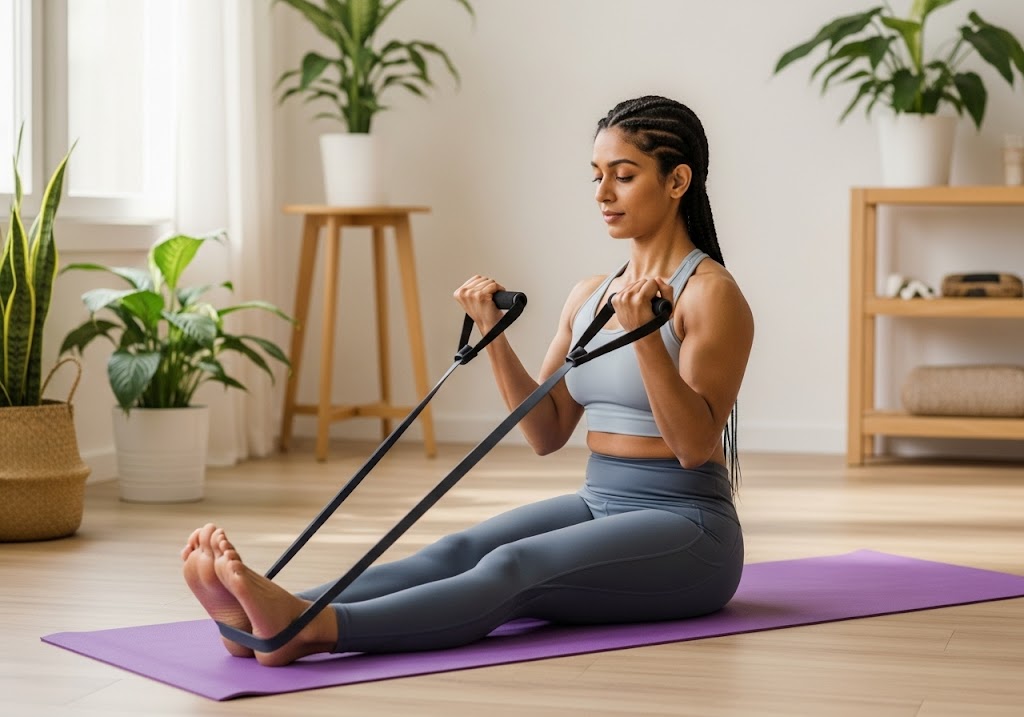
Common Mistakes in Resistance Band Bicep Workout
Avoiding common mistakes ensures optimal results from your resistance band bicep workout while preventing injury and training plateaus. These errors often limit progress and reduce the effectiveness of band training for bicep development.
- Using Insufficient Resistance: Many people underestimate band training and use too light resistance, limiting muscle-building potential
- Allowing Band Slack: Letting bands go loose eliminates constant tension that makes elastic resistance uniquely effective
- Poor Form: Swinging, using momentum, or incomplete range of motion reduces muscle activation and increases injury risk
- Neglecting Progression: Failing to increase difficulty through heavier bands, more reps, or advanced techniques
- Overtraining: Training biceps daily without adequate recovery prevents muscle growth and increases injury risk
- Limited Exercise Variety: Relying on only basic curls neglects complete bicep development from all angles
- Ignoring Eccentric Phase: Rushing the lowering portion wastes half the muscle-building potential of each repetition
Recognition and correction of these mistakes accelerates bicep development while maintaining training safety and effectiveness with your resistance band bicep workout. Focus on one correction at a time rather than trying to fix everything simultaneously in your resistance band bicep workout sessions.
Nutrition for Bicep Development
Proper nutrition supports the muscle-building demands of resistance band bicep workout training through adequate protein intake, strategic meal timing, and optimal hydration. Diet determines how effectively your body responds to training stimulus and builds muscle tissue for maximum bicep development results.
| Nutrient | Daily Target | Timing | Best Sources | Benefits |
| Protein | 1.6-2.2g/kg bodyweight | Post-workout priority | Chicken, Fish, Eggs, Whey | Muscle protein synthesis |
| Carbohydrates | 3-5g/kg bodyweight | Pre/Post workout | Rice, Oats, Fruits | Energy for training |
| Fats | 0.8-1.2g/kg bodyweight | Away from training | Nuts, Oils, Avocado | Hormone production |
| Water | 35ml/kg bodyweight | Throughout day | Water, Herbal teas | Hydration, recovery |
| Creatine | 3-5g daily | Post-workout | Supplement | Strength, power |
| BCAAs | 10-15g | During workout | Supplement | Muscle preservation |
For comprehensive nutrition strategies that support muscle building, intermittent fasting plan provides structured approaches to eating for body composition goals.
Recovery and Muscle Growth
Recovery enables muscle growth from resistance band bicep workout training through proper rest, sleep, and stress management. The muscle-building process occurs during recovery periods, not during training sessions themselves, making adequate recovery essential for optimal bicep development and strength gains.
| Recovery Factor | Optimal Range | Impact on Growth | Strategies |
| Sleep Duration | 7-9 hours nightly | Hormone production | Consistent bedtime |
| Rest Between Sessions | 48-72 hours | Muscle protein synthesis | Alternate muscle groups |
| Stress Management | Low-moderate levels | Cortisol regulation | Meditation, relaxation |
| Active Recovery | Light movement | Blood flow enhancement | Walking, stretching |
| Hydration | 35ml/kg bodyweight | Nutrient transport | Consistent water intake |
| Protein Timing | Within 2 hours post | Growth stimulation | Post-workout meals |
For complete fitness development that includes recovery considerations, full body calisthenics workout provides comprehensive training approaches.
Conclusion
A resistance band bicep workout provides an effective, convenient, and versatile approach to building impressive arm strength and size. From basic curls to advanced techniques, bands offer unique training benefits through accommodating resistance that maximizes muscle activation throughout the entire range of motion. Whether training at home or supplementing gym workouts, the bicep workout with bands combines proper exercise selection, progressive overload, and consistent application for remarkable results that prove resistance bands are valuable tools for serious bicep development and overall arm training success.
Want to master the calisthenics handstand and take your skills to the next level? Whether you’re a beginner or pushing advanced skills, ISC – Indian School of Calisthenics offers expert guidance to help you master bodyweight training. Visit us at SRPF Ground, NH8, Goregaon (E), Mumbai – 400065. For class schedules, personalized coaching, or more details, call +91 77159 53218. Train smart, move better, and unlock your back strength with ISC.
Resistance Band Bicep Workout – FAQs
Can I build biceps with resistance bands?
Yes, resistance bands effectively build biceps through variable resistance that provides constant tension and accommodating resistance patterns for optimal muscle growth.
Can you really build muscle with resistance bands?
Scientific research confirms resistance bands can build muscle mass and strength equivalent to traditional weights when used with proper intensity and progression.
Can you train biceps without weights?
Yes, biceps can be effectively trained using resistance bands, bodyweight exercises, and other equipment-free methods with appropriate progressive overload principles.
How to do bicep curls with a resistance band?
Stand on band, hold handles with palms up, keep elbows at sides, curl handles to shoulders, squeeze biceps, lower slowly with control.
What is the best exercise to get bigger biceps?
Standing bicep curls with progressive resistance provide the best foundation for bicep growth, combined with hammer curls for complete development.
How to do hammer curls with resistance bands?
Perform curls with palms facing each other throughout the movement, focusing on the brachialis muscle underneath the biceps for arm thickness.
How to do bicep curls for beginners?
Start with light resistance, focus on proper form, perform 12-15 reps, keep elbows stationary, and progress gradually over time.
Can you build biceps with cables?
Yes, cable machines provide constant tension similar to bands and effectively build biceps through various angles and resistance patterns.
How to do concentration curls?
Sit with elbow braced against inner thigh, curl one arm at a time with maximum focus on peak contraction for bicep isolation.
Can I build my chest with resistance bands?
Yes, resistance bands effectively build chest muscles through pressing movements, flyes, and various angles with progressive resistance.
Should I use straps for biceps?
Straps are generally unnecessary for bicep training as grip strength development complements arm training and builds functional strength.
Can I build triceps with resistance bands?
Yes, resistance bands effectively build triceps through extensions, pushdowns, and pressing movements with accommodating resistance.
How to slim arms with resistance bands?
Combine resistance training with cardiovascular exercise and proper nutrition for fat loss while maintaining muscle tone and definition.
Can I workout with resistance bands?
Yes, resistance bands provide complete workout possibilities for all muscle groups with proper exercise selection and progressive programming.

